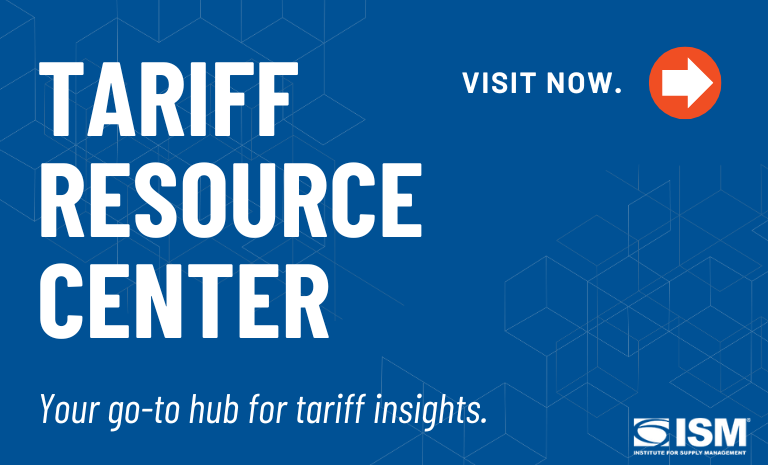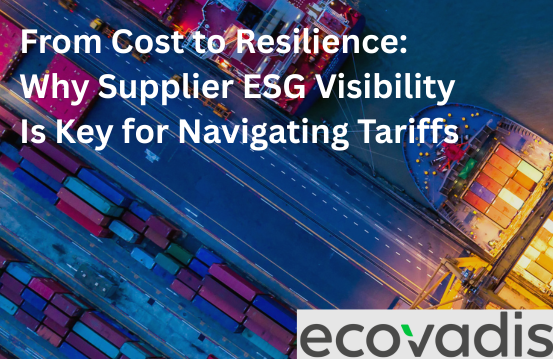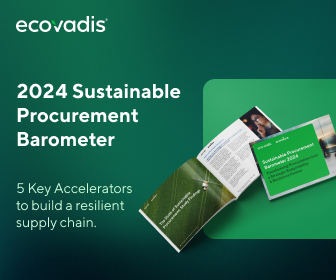From Cost to Resilience: Why Supplier ESG Visibility Is Key for Navigating Tariffs
Sponsored by Ecovadis
Trump’s shifting tariffs are forcing US companies to rethink supplier strategies – but without ESG visibility, supply chain pivots may come with costly risks.
The Trump administration’s far-reaching – and constantly shifting – tariffs are reshaping global trade and pushing many US companies to reinvent where and how they source. A 90-day pause on new tariffs for most countries has offered some relief for US companies, but with nearly all Chinese goods now subject to a 125% tariff, procurement teams face intense pressure to adapt. Companies can’t afford to wait for clarity from the new administration: they must act quickly to build diverse and resilient supply chains capable of navigating this new landscape.
More than half of companies in a recent survey say new tariffs are pushing them to change suppliers. But sourcing shifts bring hidden challenges – from compliance hurdles to environmental, social, and governance (ESG) blind spots that carry legal and reputational risks. It’s not just about finding new suppliers – it’s about building long-term resilience amid growing uncertainty and volatility.
Download our latest ebook for a five-step framework to build a more resilient supply chain.
The Real Cost of Tariffs
Much of the tariff conversation focuses on rising costs – and for good reason. A 2024 Federal Reserve Bank of New York study found that earlier US-China tariffs reduced sales, eroded profits, and triggered layoffs. The latest wave may push input costs even higher – especially for manufacturing and electronics – and brings strategic, operational, and financial risks:
- Supplier disruptions & ESG risks: Switching suppliers can cause delays, capacity issues, and compliance gaps. Many alternative markets have weaker labor and environmental standards, increasing ESG risks. Without proper visibility and due diligence, companies may trade one problem for another.
- Regulatory complexity & compliance costs: Tariffs add another layer of complexity for US procurement teams already grappling with obligations under the UFLPA and the EU’s upcoming CSDDD. New supplier compliance and performance checks will increase costs and due diligence demands.
- Market volatility & long-term risk: Shifting sourcing to lower-tariff regions may introduce hidden risks, including geopolitical instability, currency fluctuations, and sudden regulatory Companies must weigh short-term relief against long-term continuity.
Shifting Supply Chains: New Markets, Familiar Risks
US supply chains have evolved in response to pandemic disruptions and trade uncertainty. Nearshoring to Mexico and Canada has gained momentum, though Trump’s on-again, off-again tariffs have dampened some of that enthusiasm – at least in the short term.
By the end of 2024, a record number of US companies were already relocating supply chains from China. With a prolonged US-China trade war now likely, this trend will only accelerate.
Vietnam, India, Thailand, Malaysia, and Brazil – along with several other Latin American countries – are emerging as top alternatives. Yet ESG risks in these regions remain high. Vietnam, a key hub for US supply chains outside of North America, has been flagged as high risk for forced labor. Other markets also present significant challenges, including labor exploitation, weak regulatory enforcement, and corruption.
Without multi-tier ESG visibility, companies risk encountering the same environmental and human rights issues in new sourcing regions – leading to supplier disruptions, compliance violations, and reputational damage.
ESG Intelligence as a Business Imperative
For procurement teams balancing rising costs and regulatory demands, supply chain sustainability isn’t just about risk mitigation – it’s a driver of business value.
Gaining ESG intelligence across the supply chain and integrating it into sourcing decisions helps companies cut costs, boost compliance, and strengthen resilience:
- Lower operational expenses: Sustainable suppliers improve efficiency through clean energy, optimized logistics, and waste reduction – driving long-term savings.
- Improved regulatory compliance: ESG visibility enables high-quality data collection that helps companies stay ahead of regulations and reduce legal and reputational risk.
- Greater resilience: Engaging suppliers on ESG performance improves outcomes over time – reducing volatility and strengthening the entire supply network.
How EcoVadis Helps Procurement Teams Move Faster – and Source Smarter
Navigating the volatile tariff landscape – and seizing the opportunities it creates – requires a new approach to supplier visibility and ESG risk management. EcoVadis solutions provide companies with the insights and tools to:
- Map ESG risks at scale with IQ Plus – get supplier, industry, and regional insights.
- Accelerate compliance using Vitals, a supplier questionnaire that flags ESG and due diligence gaps.
- Monitor supplier risks in real-time with Worker Voice – an always-on platform that delivers live ESG workplace data from across your supply chain.
- Benchmark performance with EcoVadis Ratings to inform sourcing decisions.
- Drive supplier improvement and collect high-quality ESG data for reporting and compliance.
With no end in sight to global trade uncertainty and ESG regulations tightening, companies can’t afford to wait for clarity. These tools are helping procurement leaders act now – reducing critical risks in the short term while building long-term resilience, compliance readiness and competitiveness.
Book a demo to get started.


